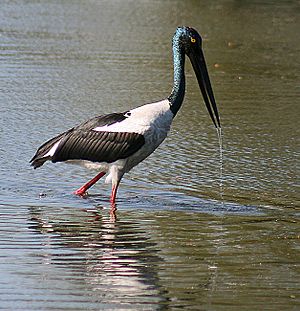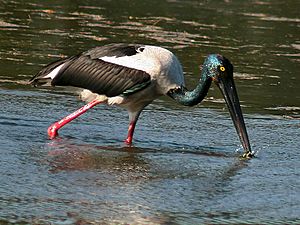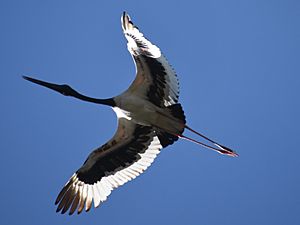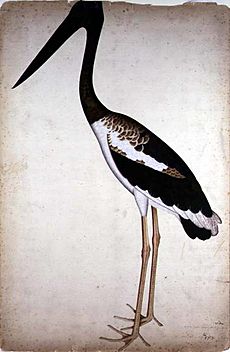Black-necked stork facts for kids
Quick facts for kids Black-necked stork |
|
|---|---|
 |
|
| Male | |
| Conservation status | |
| Scientific classification | |
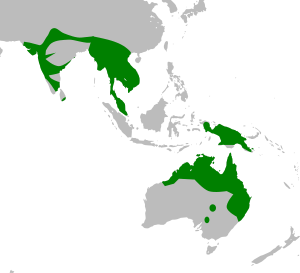 |
|
| Synonyms | |
|
The black-necked stork (Ephippiorhynchus asiaticus) is a very tall bird with a long neck. It belongs to the stork family. These birds live in India, Southeast Asia, and Australia. They prefer wet places like wetlands and fields where crops like rice grow. Here, they hunt for many different animals to eat.
Both male and female adult black-necked storks have a strong bill. Their feathers are mostly white and shiny black. However, you can tell males and females apart by the color of their eyes. In Australia, this stork is sometimes called a jabiru. But the name "jabiru" actually refers to a different stork species found in the Americas. The black-necked stork is one of the few storks that strongly protects its feeding area from other birds.
Contents
About the Black-necked Stork

The black-necked stork was first described by John Latham in 1790. Later, scientists decided to place it in the genus Ephippiorhynchus. This genus also includes the saddle-billed stork from Africa. They were grouped together because they look and act similarly.
There are two main groups, or subspecies, of black-necked storks. One lives in Asia (called E. a. asiaticus). The other lives in New Guinea and Australia (called E. a. australis). Even though they live in different places, scientists usually consider them to be the same species.
What Does a Black-necked Stork Look Like?
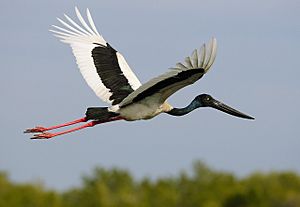
The black-necked stork is a very large bird. It can stand about 129 to 150 centimeters (51 to 59 inches) tall. Its wingspan can reach up to 230 centimeters (91 inches).
Adult storks have a shiny bluish-black head, neck, and tail. Their back and belly are bright white. Their bill is black, and their legs are bright red. You can tell the difference between male and female adults by their eyes. Females have yellow eyes, while males have brown eyes.
Young storks look different. When they are very young (under six months), they have brownish eyes and a smaller, straighter bill. Their head, neck, and upper back are brown, and their belly is white. As they get older, their feathers start to show some of the adult colors.
Like most storks, the black-necked stork flies with its neck stretched out. It does not pull its neck back like a heron. When it flies, you can see a black bar across its white wings. This helps to tell it apart from other birds.
Where Do Black-necked Storks Live?
In India, these storks are common in the west, central areas, and northern plains. They are less common in southern India and Sri Lanka. They are also found in Southeast Asia, New Guinea, and the northern part of Australia.
The largest group of black-necked storks lives in Australia. They can be found across northern Australia, from Western Australia to New South Wales. They are rare in the far south-east of their range.
In India, many black-necked storks live in farming areas in Uttar Pradesh. They build their nests on tall trees in quiet parts of large marshes or in fields. They often choose trees that are big and have wide branches.
Black-necked storks look for food in many different wet places. They like natural wetlands such as lakes, ponds, marshes, and rivers. They also use man-made wet areas like flooded fields, irrigation canals, and even sewage ponds. In farming areas, they prefer natural wetlands, but they will use flooded rice fields during the rainy season.
How Do Black-necked Storks Behave?
Black-necked storks have a special dance-like display. A male and female will walk towards each other, facing each other. They spread their wings and flutter them quickly. They move their heads forward until they touch, then clatter their bills together and walk away. This display can last for about a minute and may be repeated.
In India, storks start building nests during the monsoon season, usually from September to November. They build large nests, about 3 to 6 feet wide, made of sticks and branches. They often line their nests with plants and sometimes mud. These nests can be used year after year.
A female stork usually lays four eggs, but can lay between one and five. The eggs are dull white. Both parents take turns sitting on the nest. When one parent returns, they greet each other by opening their wings and moving their heads up and down.
Adult storks bring food to their young chicks and drop it onto the nest. After about three or four months, the parents stop feeding the young at the nest. They might even start to act a bit aggressive towards them. The young birds may stay nearby for about a year before they leave. Usually, one to three chicks survive and leave the nest, but up to five can fledge in years with a lot of rain.
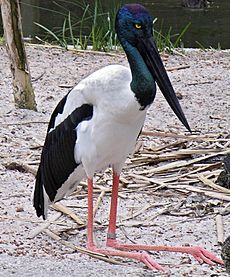
Black-necked storks are meat-eaters. They eat water-birds, fish, frogs, reptiles, and invertebrates like crabs and snails. They have even been seen eating the eggs and baby turtles from nests buried in the sand. In Australia, they sometimes hunt at night for baby sea turtles coming out of their nests.
These storks often soar high in the sky on warm days or rest on their hocks (a joint in their legs). When they drink, they scoop up water with their open bill and then tilt their head back to swallow. They sometimes carry water in their bills to their chicks or even to the nest during building or egg-laying.
Black-necked storks are usually quiet. They mostly make bill-clattering sounds, especially at the nest. Young birds might make soft, high-pitched whistles to ask adults for food.
These storks are not very social. You usually see them alone, in pairs, or in family groups. Sometimes, you might see small groups of up to 15 storks. This happens when wetlands dry up, forcing them to gather in smaller wet areas.
Status and Conservation
It's hard to count black-necked storks because they are spread out and not found in large numbers in any one place. There are only about 50 birds in Sri Lanka, and they are very rare in countries like Thailand and Myanmar. The total number of storks in South and Southeast Asia is thought to be less than 1,000 birds.
The black-necked stork is listed as "Near Threatened" on the IUCN Red List. This means they are not in immediate danger, but their numbers could become threatened in the future.
The biggest dangers to black-necked storks are:
- Habitat loss: When their wetland homes are destroyed or drained.
- Disturbance: People bothering them at their nests.
- Overfishing: Not enough fish for them to eat.
- Pollution: Water pollution affecting their food and health.
- Collisions: Flying into electricity wires.
- Hunting: Being hunted in some areas.
More research is needed to understand how many storks there are and how well they are breeding.
Black-necked Storks in Culture
In Bihar, India, there was a tradition where a young man had to catch a black-necked stork alive before he could get married. This was a very dangerous ritual because the stork could be fierce. This tradition stopped in the 1920s after a young man was killed. In some parts of Assam, young storks were taken from nests for meat.
In Australia, some Aboriginal myths tell stories about the "jabiru" (black-necked stork). One story says the stork's bill came from a spear that went through a bird's head. The Binbinga people sometimes consider the stork's meat taboo. They believe eating it could harm an unborn child. The jabiru is known as "karinji" and is a special totem for a group called the Karinji people.
The difference in eye color between male and female storks was first noticed in 1865. Charles Darwin knew about this and used it as an example of how male and female birds can look different.
See also
 In Spanish: Jabirú asiático para niños
In Spanish: Jabirú asiático para niños



